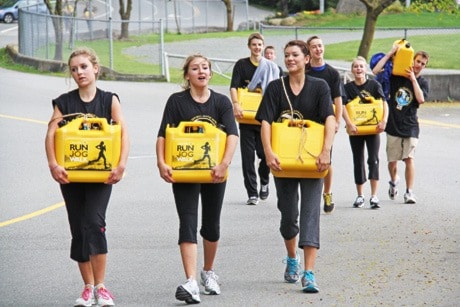Michelle Watrin
Contributor
Trying to replicate the plight of girls in Ethiopia for the upcoming Run for Water in an “Empathy Walk,” a dozen MEI Grade 9 students took the day off from school on Friday and set off for Mill Lake with empty jerry cans.
They filled the cans with water from the lake, and made the second part of the trek back to MEI bearing the weight of the water on their backs, fronts, shoulders and even on their heads.
“You had to keep shifting the weight and changing positions,” student Kassy Kasdorf explained.
The 21.6 kilometre endeavor took five and a half hours.
Moments after they returned to MEI, they stood together patting each other on the backs and taking pictures, much like a sports team that had just won a match. The periphery of their hair was covered in sweat, and their legs, arms, shoulders and backs were aching, but their eyes were still bright and full of life.
Their comments showed they had gained a new appreciation for what Ethiopian women endure.
“It is HARD work.”
“How easy we have it.”
“[Walking to gather water] is really, really intense.”
“Water is heavy.”
The group giggled at the last answer, but agreed all the same.
“It’s not fair,” Paul Cazan said. “Guys don’t have to walk for water [in Ethiopia]. They work in the fields and some go to school. I would take working in the fields any day over walking that long for water.”
“And the water isn’t even clean,” Indiana Letkemann added. “After all that walking, it is for dirty water. Mill Lake’s water is not clean drinking water, but neither is the water the girls in Ethiopia walk for every day.”
The fact many girls walk all day to gather water for their family that is full of germs and disease hit home through the experience, she said. The students realized their many breaks for food and water (out of water bottles) during the trek would be considered luxurious to the girls in Ethiopia, who do somewhat similar treks every day. They also acknowledged their athletic shoes, parental support, and mild temperatures made their trek much easier.
“People in North America use about 82 gallons of water a day,” Samantha Schroeder said. “[People in Ethiopia] only use about four gallons a person. You get a whole new respect for them, and realize how easy we have it here.”
Jodi Tilitky agreed. “Now we know why we are running for water. We only did this for one day; they do this every day.”
Most of the group plans to run the 10K run on May 27th at Mill Lake Park. After their experience, running a 10 k should be a breeze.
“We wanted to see what it was like to walk for water, and now we really care about this cause,” said Kaitlyn Burkinshaw.
For more information, go to www.runforwater.ca.
